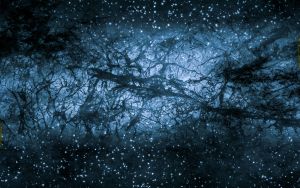Dark matter
Dark matter is currently believed to be a form of matter accounting for approximately 85% of the matter in the universe and about 27% of its total mass–energy density. Its presence is implied in a variety of astrophysical observations, including gravitational effects that cannot be explained by accepted theories of gravity unless more matter is present than can be seen. For this reason, most experts think that dark matter is abundant in the universe and that it has had a strong influence on its structure and evolution. Dark matter is called "dark" because it does not appear to interact with the electromagnetic field, which means it does not absorb, reflect, or emit electromagnetic radiation, and is therefore difficult to detect.
Primary evidence for dark matter comes from calculations showing that many galaxies would fly apart, or that they would not have formed or would not move as they do, if they did not contain a large amount of unseen matter. Other lines of evidence include observations in gravitational lensing and in the cosmic microwave background, along with astronomical observations of the observable universe's current structure, the formation and evolution of galaxies, mass location during galactic collisions, and the motion of galaxies within galaxy clusters. In the standard Lambda-CDM model of cosmology, the total mass–energy of the universe contains 5% ordinary matter and energy, 27% dark matter and 68% of a form of energy known as dark energy. Thus, dark matter constitutes 85% of total mass, while dark energy plus dark matter constitute 95% of total mass–energy content.
Although the existence of dark matter is generally accepted by the scientific community, some astrophysicists, intrigued by certain observations which are not well-explained by standard dark matter, argue for various modifications of the standard laws of general relativity, such as modified Newtonian dynamics, tensor–vector–scalar gravity, or entropic gravity. These models attempt to account for all observations without invoking supplemental non-baryonic matter.
